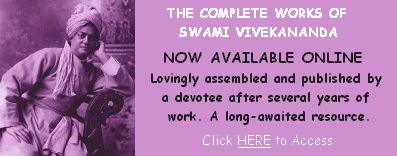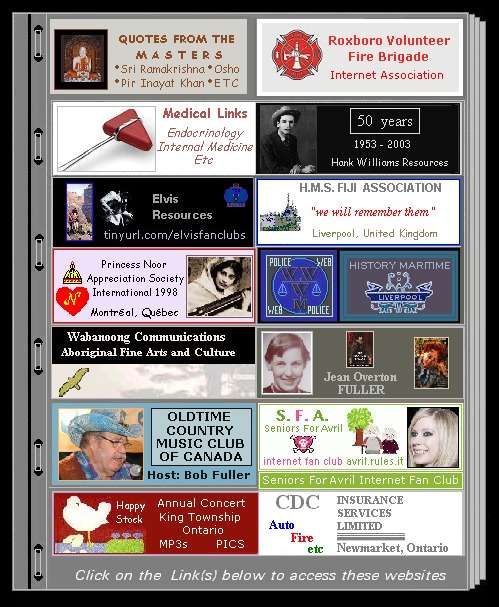

 Listen to a 60 second rendition of the Gayatri Mantra
Listen to a 60 second rendition of the Gayatri Mantra 



|
Master = Thakur = Sri Ramakrishna Compliments of Dr. C. S. Shah Regret to inform you that father passed away on 24th Apr 2004 leaving his fond memories and imprints on my heart. Shantanu [Dr C S Shah's son] .....Thus a nucleus of sangha - mission - evolved around Thakur in his presence with the help and efforts of his monk-like disciples, Swami Vivekananda, in particular. In these critical days of his illness Sri Ramakrishna made certain important moves. He called Narendra and told him 'to take care of these boys', i.e. his brother disciples, lest they should go back to the worldly life. Swami Vivekananda was to become their leader and see to it that they were properly trained and cared for as sannyasins. Secondly, Sri Ramakrishna once wrote, 'Naren will teach.' Naren, at that time only 22 years of age, never dreamt of such a role in future life, but the telescopic vision of the Master could see the future role of Swami Vivekananda as the world teacher and world leader. He said, "Naren, at present you may deny and protest, but I tell you, your very nature would get this work done through you. The Mother would see to that you spread Her message all over." Thus, the mantle of leadership fell on the broad, powerful pure, and wise shoulders of Narendranath. One day, about three days prior to his leaving this world, Sri Ramakrishna called Swami Vivekananda and transferred all his spiritual powers to him, saying, "O Naren, today I have given you everything I had, and have become a fakir, a pauper." And the last stroke was very touching, amusing a bit, and full with insight. Skepticism had not yet died down completely from the mind of Swami Vivekananda. One day he was sitting at the holy feet of his ailing Master when a thought arose in his mind, 'If now in this condition of distress if the Master tells me he is Avatar Purusha, then I will accept him as the greatest of God Man." As soon as the thought arose in the mind of Swami Vivekananda Sri Ramakrishna, though weak and unable to get up, said, 'Even now you have doubts! O Naren, the same Rama and the same Krishna are embodied in this body as Ramakrishna. I am speaking the truth.' Thus was completed the training, revelations, and transfer of all the spiritual powers from the Master to his most able disciple for the welfare and benefit of future mankind. All doubts vanished from the heart and mind of Narendranath; he had become one with the Master. Therefore, we say that Sri Ramakrishna's spiritual experiences and powers were so vast that they could not be contained in one body. It required three bodies, those of Sri Ramakrishna, Holy Mother Ma Saradadevi, and Swami Vivekananda, the Holy Trio, for its full expression. Sri Ramakrishna left the worldly abode on 16th August 1886. To fulfill his Master's desire, Swami Vivekananda now rented an old house at Baranagore and converted it into a monastery, where all his grief-stricken (but firm in determination) brother disciples started staying in great atmosphere of brotherhood. They daily worshiped Sri Ramakrishna in his photo image (I shall send you one) and everyone shared the work of begging for the food, worshiping the Master, teachings his message, and reading from the ancient Indian scriptures, viz. the Gita and Upanishads. The Ramakrishna Mission had come to life. What next? The Soul Wants to Soar High Swami Vivekananda's realization of the highest Truths, both in its formless and personal aspects, acted as 'theoretical' confirmation of the highest Vedantic principles as laid down in Upanishads. They remained confined in the heart of Narendra making him aglow with effulgent divinity, but the condition of his mind was like the trapped bird in a golden cage. It wanted to spread its mighty wings, strengthened with the power of nondual realizations and teachings of the Master, far afar. It wanted to soar high in limitless sky to cover the whole humanity under its massive wings and make them aware of those invaluable truths. The restlessness reached the stage when Swami Vivekananda could no longer confine himself to the four walls of Baranagore monastery. He intently desired to go into open world to learn more of practicality of Vedanta. How can Vedanta be applied in day-to-day life to alleviate the sufferings of the masses! Is it possible? Such and many similar questions crowded his mind from dawn to dusk and from dusk to dawn. And one day, alone, sometime in July 1888, Swami Vivekananda left Calcutta telling his brother disciples not to follow him. Thus started the second important phase in the life of Swami Vivekananda, the Parivrajaka Monk, wandering years of the Swami. He went to Varanasi, Ayodhya, Vrindavan, Lucknow, Agra, and the Himalayas, thus covering the entire north of India. These are the great places of historical importance due to their socio-religious and spiritual importance. These are the places connected with life and teachings of Rama and Sri Krishna, Sita and Radha who glorified divine love and dharma as the final culmination of spiritual quest. There is that great Himalayas where loneliness prevailed and called the individual sadhaka to ready himself/herself to merge into the glory of Infinite. This was a short trip and the swami returned back to Calcutta in a few months' time. For sometime he remained in the company of his brother disciples trying to devise the means and the ways to propagate their Master's message to every nook and corner of India, and world! But his future plans could but be sketchy, for he didn't understand how to go about it. The force of knowledge was very great in his heart, acting as if like a silent bomb, which no one knew when and where would it burst. The restlessness could not be contained in the narrow confines of his head and heart; it must come out to cover all the sky. And hence, for the second time in around July 1890, he left his brothers to wander all over the country, after seeking blessings from Ma Saradadevi. On pilgrimage of India For two years and more, he wandered all over from north to west, from west to southern tip of India learning and assimilating the prevalent religio-social culture and condition of India and her children. And what did he see? He saw that the masses submerged in deep poverty, ignorance, illiteracy, and superstition. The many years of foreign rule and estrangement from the wisdom of Upanishads have made them slaves not only of British rule, but also of the outdated social customs and rituals. The meanings of God, religion, dharma etc. were distorted to their lowest and crudest level. In the face of utter poverty, food itself had become their dharma and God. And, indeed, the Swami once acceded, 'Religion can't come on empty stomach. For poor religion comes in the form of bread.' Give bread, give secular education, improve their material condition, cover their half-naked bodies with some semblance of decency, and then tell the masses about spirituality. Then talk of realization of Atman and Brahman, God and Religion. Oh, my Mother India, to what pitiable condition you have come to. His heart cried out in silence, and his eyes shed silent tears of sorrow at the suffering of masses. The mighty Jnani in the Swami became the compassionate saint like that Buddha. Bhakti and Jnana must be activated with Selfless Karma; it must be so. Do something for the masses; that was the pressing necessity. And thus indeed he resolved. Tears of anguish softened and broadened his heart, and one day he said, "O brother, I do not know the meaning of religion; but one thing is sure, now I feel my heart has broadened and is capable of accommodating and feeling for everyone, be he destitute or a king, healthy or afflicted. I see the same Narayana in poor and fool, wealthy and wise." Swami Vivekananda's plan for future course was taking shape gradually. He must do something to alleviate the suffering of the Indian people. He was ready to keep sadhana and mediation to the side for time being so that he could devote himself fully in this cause. He also thought of going to rich countries like America and earn such a large amount of money that could help him in fulfilling his pledge! To work is to worship; that was the new mantra that, Swami Vivekananda thought, would help India rise again. Sacrifice, renunciation and service were the essential requisites for this dream to come true and for India to come out of darkness of ignorance and poverty. Material progress, secular education, and service to sick must be added to meditation and spiritual practices for fulfillment of final spiritual aim. Parivrajaka Sadhu: The 'wandering monk' By 1892 Swami Vivekananda became a sage of high intellect, action, and devotion. In his life, he had experienced the Truth of all four Yogas, viz. Yoga of meditation, discrimination, action, and devotion. He was well versed in the study of Vedas, Upanishads and Bhagavad Gita. He also studied life and teachings of Jesus Christ, Prophet Mohammed, and Lord Buddha. In fact it is believed that once Swami Vivekananda had the vision of Buddha in his deep meditation. Thus having acquired direct knowledge of all the religions, having come to the conclusion that all religions speak of the same truth, Swami Vivekananda had intense desire to spread this wonderful message of Unity of Existence and Unity in Diversity. Accordingly he continued to travel all over the Holy Land of India to get the first hand information about the state of religion in the Indian masses. The vast land opened up a new challenge before the Swami to explore its religious-spiritual truths. These days of a 'wandering monk' make an important stage in the history of spiritual revival of India as well as the whole world. Why? Because, his experiences during the wandering days added compassion to his broad outlook and sharp intellect! He could understand the sad plight of fellow countrymen, their exploitation, poverty, suffering and affliction under the mercy of foreign rule and darkness of ignorance. "To the hungry religion comes in the form of bread", he declared. And he would have added, "And for the ignorant religion comes in the form of education". Material progress and spiritual uplift are not contradictory, are not antagonist to each other, but, rather, to bridge the yawning gap between the two should be the goal of religion, he maintained. He was convinced that science and religion should join hands so that a new chapter may be written in the human history. He saw, learnt, and was convinced that while material progress of India was as important as the spiritual revival, to the West religion would come in the form of spiritual blend to the materialism. He met with many eminent and noble persons, the Maharaja of Khetri, Dewan of Porbandar and Junagadh, Raja of Ramnad, and many intellectuals in the state of Rajasthan, Gujarat, Maharashtra and Madras. All these gentlemen were highly impressed by the sincerity, knowledge, spirituality and new Vedantic approach to life of this English speaking Monk. And then, once during casual discussion, the Dewan of Porbandar said, "Swamiji, I am afraid you cannot do much in this country. Few will appreciate you here. You ought to go to the West where people will understand you and your worth. Surely you can throw a great light upon Western culture by preaching the Sanatana dharma!" "The poverty ridden illiterate people of our country are not yet ready to receive the message of Vedanta. Why don't you attend the Parliament of Religions to be held in Chicago a few months hence? There you represent and elaborate the true Hinduism of which your Guru, Sri Ramakrishna, was the living embodiment." Swami Vivekananda began planning for his visit to America, and on 31st May 1893 he set sails for that far off land; the ochre robed sadhu planning to conquer the scientific reason of West with Vedantic intuition of the East. |




  |

Interesting Places to Visit
Swami Vivekananda - the Universal Man - Part One
Quotes from Sri Swami Vivekananda
RK Digest Chatroom and Message Board
Another Sri Swami Vivekananda Site
Visit Site dedicated to the Holy Mother
Visit site dedicated to "M", Author of Gospel of Sri Ramakrishna
Visit Sri Sri Ramakrishna Paramahamsadeva Site
Visit DAKSHINESWAR temple near Calcutta
SRI SARADA NAHABAT GUESTBOOK
Vedanta Society of Toronto
Visit the RAMAKRISHNA MATH at Chennai, India
DAILY SUTRAS collected and prepared by EM Hashim
Sanscrit Etymological Sources






